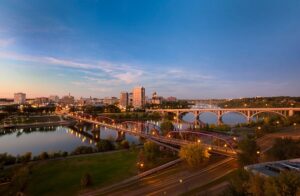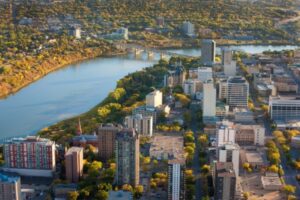Change Status Inside Canada Saskatchewan

Change Status Inside Canada Saskatchewan
Nestled in the heart of Canada, Saskatchewan is referred to as the Land of the Living Skies due to its vast, unobstructed horizons and stunning sunsets that paint the sky with a vibrant array of colors. Its land area spans 651,900 square kilometers, with a population of 1,132,505 individuals. The capital of the province is Regina, while the largest city is Saskatoon. The main ethnic groups in Saskatchewan are English, Scottish, German, Ukrainian, and Indigenous peoples. English is the most widely spoken language in the province, followed by Indigenous languages, German, Ukrainian, and Tagalog.
Saskatchewan takes pride in its rich cultural heritage. Visitors can explore the history and traditions of Indigenous peoples at places like Wanuskewin Heritage Park and the Saskatchewan Indian Cultural Centre. History buffs can explore Saskatchewan’s historic sites, such as Fort Battleford National Historic Site, Batoche National Historic Site, and the RCMP Heritage Centre.
From world-class fishing and hunting opportunities to thrilling water sports, Saskatchewan offers plenty of adventures for outdoor enthusiasts. The Meewasin Valley Trail and the Great Sandhills are popular destinations for hiking, birdwatching, and experiencing unique landscapes.
Due to its breathtaking natural wonders, thriving cities, and vibrant cultural scene, over 12,000,000 foreigners visit Saskatchewan each year. About a quarter of them decide to change status inside Canada. Keep reading this article to explore how to change status inside Canada in different situations.
Change Visitor Visa to Study Permit in Saskatchewan:Change Status Inside Canada Saskatchewan
The first situation when you need to change status inside Canada is the transition from a visitor visa to a study permit. A visitor visa allows foreigners to remain in Canada until the expiry date indicated on their visitor records. They cannot study under a visitor visa. Hence, individuals who enter the country on a visitor visa and later decide to pursue studies must change status inside Canada and obtain a study permit. This document enables you to pursue your study program at a Designated Learning Institution (DLI) and stay in the country for the duration of the program.
According to the Canadian government, there are specific groups of foreigners who are eligible to change status inside Canada and acquire a study permit. These include individuals holding a visitor visa valid for a minimum of six months, along with their family members. Additionally, the eligible category encompasses minors studying at the preschool level, as well as those who have completed a short-term course necessary for their enrollment at a DLI.
Furthermore, visiting or exchange students studying at a DLI, refugee claimants, protected persons, family members of Canadian-based team athletes, media representatives, members of the clergy, and military personnel assigned to Canada are eligible to change status inside Canada.
Minor international students who want to attend primary or secondary school need to acquire a letter from the school indicating the intended level of study and completion date. Foreigners who want to change status inside Canada and pursue post-secondary study programs must obtain a letter of acceptance from the DLI.
To change status inside Canada and get the study permit, you need to submit an Application to Change Conditions, Extend my stay or Remain in Canada as a Student [IMM 5709], photocopies of your passport, proof of funds to cover expenses during the study, and proof of payment of $150. Parents of minor international students also ought to submit a Custodianship Declaration – Custodian for Minors Studying in Canada [IMM 5646]. It takes up to two weeks to get a study permit.

Change Study Permit to Work Permit in Saskatchewan:Change Status Inside Canada Saskatchewan
The second situation when you need to change status inside Canada is when you graduate from a DLI and want to stay and work in the country. Then, you ought to apply for a post-graduation work permit (PGWP). This permit allows graduates to change status inside Canada and work in the country for a period of up to three years.
To be eligible to obtain a PGWP, you must complete a full-time study program in the DLI that was at least two years and led to a degree, diploma, or certificate. If you want to change status inside Canada and apply for the PGWP, your study permit must remain valid for a minimum of 180 days.
During the application process to change status inside Canada and get the PGWP, you need to provide documentation that confirms the completion of your studies. It can be a degree or diploma awarded by your educational institution, an official school letter which confirms the successful completion of your program, or a copy of your official transcript, indicating the courses you have completed and the grades you have achieved.
To get the PGWP, you should pay the work permit fee of $155, the open work permit holder fee of $100, and, if required, a biometrics fee of $85. The application processing time is about four months.

Change Status and Get a Work Permit in Saskatchewan:Change Status Inside Canada Saskatchewan
The third situation when you ought to change status inside Canada is when you get a job offer during the country visit. You must get a work permit since foreigners do not have the right to work in the country without authorization.There are eight categories of foreigners who are eligible to change status inside Canada and acquire a work permit. However, the eligibility does not guarantee the approval of your application.The categories include holders of work or study permit and their family members, post-secondary graduates, individuals who are currently employed in Canada and applying for secondary employment within the country, holders of temporary residence permits that are valid for at least six months and their family members, refugees, and foreigners whose work permits were authorized by a migration office abroad but was not issued in the port of entry. In-Canada permanent resident applicants, along with their family members, who belong to humanitarian and compassionate considerations (H&C), live-in caregivers, an interim pathway for caregivers, spouses or common-law partners, and protected person classes that are eligible for permanent resident status can change status inside Canada and get a work permit.Moreover, Mexican visitors can change status inside Canada and apply for a work permit under the Canada-United States-Mexico Agreement (CUSMA). On the other hand, U.S. visitors may apply for a work permit only under the Professional or Intra-company Transferee of CUSMA.
To change status inside Canada and obtain a work permit, your employer must give you a copy of the LMIA (Labour Market Impact Assessment). LMIA-exempt employers need to give you the Offer of Employment number.In addition, when you apply to get a work permit and change status inside Canada, you ought to submit an Application to Change Conditions or Extend Your Stay in Canada [IMM 5710], photocopies of your passport, photocopies of your current immigration document, photocopies of your marriage certificate, and proof of payment. An officer in charge may also require additional documents.The processing fee is $155, but if you are eligible for an open work permit, you need to pay an additional $100. If required, you should pay a biometrics fee of $85. The processing time to change status inside Canada and get a work permit is up to five months.

Change Work Permit to Permanent Residency in Saskatchewan:Change Status Inside Canada Saskatchewan
The last situation when you ought to change status inside Canada is when you qualify for permanent residency in Saskatchewan. You can apply to change status inside Canada under Saskatchewan Immigrant Nominee Program (SINT). The program includes four streams: Farm Owner and Operator, International Skilled Worker, Worker with Saskatchewan Work Experience, and Entrepreneur.The basic requirements of the provincial nomination are at least one year of work experience, at least CLB Level 4 in English, and an offer of employment under TEER 0, 1, 2, or 3 of NOC (National Occupation Classification). The specific requirements and documents to change status inside Canada depend on the chosen immigration stream.If you wish to change status inside Canada through the Canadian Experience Class (CEC), you ought to get a minimum of one year of full-time in-Canada work experience under TEER 0, 1, 2, or 3 of NOC. Furthermore, you ought to meet Canadian Language Benchmark (CLB) 7 for TEER 0 and 1 job or CLB 5 for TEER 2 and 3 jobs. The processing time and application fees of permanent residency applications depend on the chosen immigration stream.
In case, if you need help with Immigration Assistance and change status inside Canada in Saskatchewan or any other immigration services, please fill in application below or contact us directly.

